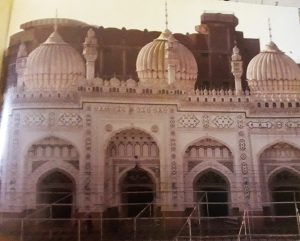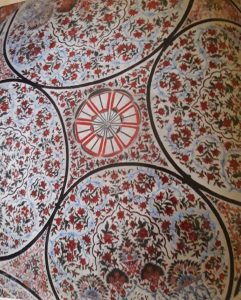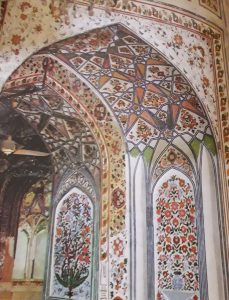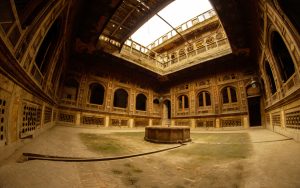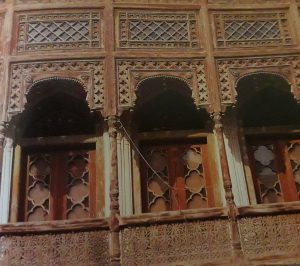Following we take a look at a spectacular specimen of Mughal architecture (the only one in Peshawar), as well as some rare residential buildings:
Mahabat Khan Mosque
Background
You can reach it through Chowk Yaadgar as the entrance to the mosque is located in the middle of ‘Jewellers Street’.
The name of the mosque had created a confusion as there was a Mahabat Khan (real name Zaman Beg), renowned general and statesman during the reign of Emperor Jahangir. However looking at the architectural grandeur of the mosque it is quite clear that it was made during the period of Emperor Shah Jahan, and named after Mahabat Khan, a military commander and administrator who served under him.
Mahabat Khan
His real name was Ali Mardan Khan, and his services earned him the highest reputation in the Mughal Court. In 1639, he received the designation of Amir ul Umara (Lord of Lords). Later on he was appointed as the Viceroy of Punjab (which comprised of the region between Kabul and Delhi). His tomb is situated on Mughalpura Road, Lahore. One of the halls at the boys hostel at University of Engineering & Technology(UET), Lahore is also named after him, and in Srinagar, Kashmir there is a Bagh-e-Ali Mardan Khan.
Features
The white marbled mosque was approximately built in 1630 on a raised terrace and is 56 meters by 50 meters. It has three entrances i.e. north, south and east. One can access the courtyard by the north and east. It has seen many changes to its features as it was badly damaged during a fire in 1898. So most of its beautification was done in the early 20th century; however the original finesse of building art that was seen during Shah Jahan’s rule is still evident.
The interior is adorned with Mughal Fresco (art that expresses the highest level of artistic creativity. It flourished the most during the Mughal rule and every building was decorated with it). The archways are beautifully decorated with multicolored vegetal motifs. The interior and exterior is done in floral motifs and geometrical figures as well as calligraphy, yet the ceiling is especially rather strikingly done in red Fresco.
Abu Tabela
The old District Gazetteer tells of how two of its minarets were used as deathly gallows by the then Governor of Peshawar, the Italian ‘General Paolo Crescenzo Martino Avitabile’. At least 3 to 5 men were hung every day.
He ruled Peshawar from 1834 – 1843 ruthlessly and became known as ‘Abu Tabela’. His name became quite a legend, even so that disobedient children were controlled simply by saying ‘Abu Tabela’.
Mohalla Sethian
Situated in the heart of the Walled City of Peshawar, Mohalla Sethian consists of unique mansions also known as ‘havelis’ built in the late 19th century, whose architecture has influences of Kashmir, Iran, Uzbekistan and India. The first was built in 1882 by Haji Ahmed Gul.
The structure is a combination of woodwork and small Kashmiri-bricks known as ‘Waziri’ which were popular in the Mughal Era. The houses consist of three portions, the basement (tehkhana), courtyard (dalan) and first floor (balakhana). The courtyards are very spacious and feature a fountain (as seen below).
Rooms can be found on each floor, where all the windows have red and green glasswork. The ceilings are not only adorned with fabulous Islamic Art and a different color for each but also with imported chandeliers.
There is an excellent ventilation system, as the roofs are connected to each other by bridges of wood, so that heat can leave. And the ventilators in the basement are placed at an angle which ensures ample daylight can come through.
However the most outstanding feature of these houses are the intricately hand carved wooden doors, balconies, windows, frames, arches and columns. They reflect highly sophisticated craftsmanship, one that cannot be found today! All in all these houses are a testament of the artistic sense and fondness of ornate décor of the residents.
The Sethis were a Punjabi Hindu trader family (main trade was wood) who had migrated from Jhelum to Peshawar. They traded with Afghanistan, Central Asia and India. Till the beginning of the 20th century they were very rich, and it is believed that they had amassed great wealth in Russian money, and kept it in their underground vaults. However when the Russian Revolution took place they lost it all as the Soviet Union introduced a new currency.
